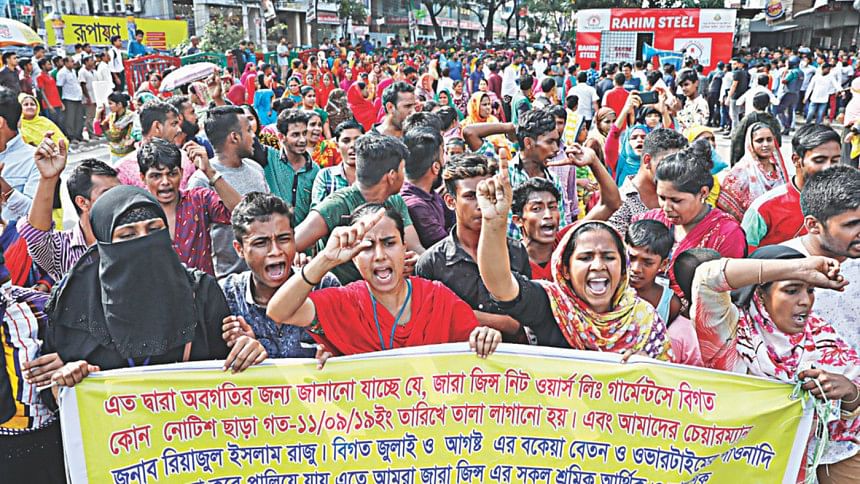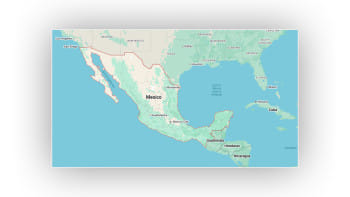What do recent layoffs in RMG factories entail?

According to reports, during the last seven months, 25 thousand workers lost their jobs and at least 40 factories had stopped production. Smaller factories had not been able to withstand the pressure of complying with all the requirements of Accord and Alliance, while larger factories got even bigger. According to BGMEA data, during 2012-2013, the number of BGMEA members were 5,876 and now it has decreased to 4,621. However, export earnings from the sector has not shrunken, rather, in 2018-2019, it stood at an all-time high, having earned more than USD 34 billion. The recent layoffs and crises, therefore, coincide three interrelated aspects, i.e., growing export earnings, smaller factories being forced out of operation, and workers being deprived of the right to a living wage.
After repeated protests, minimum wage has been set at USD 94.68, the nominal increase is deemed insufficient if we consider it in comparison with the poverty line income, or the cost of basic needs. According to the latest Household Income and Expenditure Survey 2016, the minimum amount that a person requires just to stay out of poverty is USD 26.84 per month. Frankly, a family of four members struggles to survive with only one worker's monthly income.
Ultimately, the growth in wage is distributed among other capital accumulators through house rent, medical care, education for children, just to live by. The scenario becomes even more dismal if we consider the higher thresholds of poverty line benchmarked by the World Bank, which is USD 3.2 or USD 5.5 per person per day, instead of USD 1.9—typical of lower-upper middle-income countries.
If we try to solve the crisis of our apparel industry through maintaining factory compliance or just by increasing the minimum wage, the efforts are likely to fail as we have seen during the last decade. These usual comprehensions lack basic understanding of capitalism. In the book The Enigma of Capital and the Crises of Capitalism, David Harvey argues, capital is the lifeblood of capitalist societies and we must understand the flow of capital to make sense of the condition we live as such. Thus, to make sense of the recent layoffs we must broaden the matrix of stakeholders.
With expanded purview, we can identify that global capital operating the fashion brands is afflicted by the continuous need to reproduce itself through ever-growing profit margins, even at the cost of living wages and job security. That is why despite the current emphasis on factory compliance issues, Oxfam has revealed the wage of workers account for 4 percent of the retail price and the global supply chain has not been able to absorb 17 cents which would have ensured a living wage for garment workers. Global brands display little concern for ensuring a living wage for workers; for instance, H&M had declared in 2013, it would guarantee "fair living wage" for workers of 750 supplier factories by 2018. However, it has moved away from its supposed "shared responsibility" in 2017 by revising the goal to have improved wage management systems.
Once we analyse the recent layoffs in its totality, we will not only point our fingers at the factory owners or the workers, rather we will see that the major stakeholders in this regard could be the global brands and consumers. It is true that factory owners offer ever lower prices to the buying brands, but they are bound to do that to stay in production, while the global brands are forced to keep their product pricing low to keep up their market share. Whereas many production regulations are being deployed to improve working conditions, surprisingly, the regulation of buying and market practices of clothing brands remains non-existent. Suppliers from developing countries cannot require their buyers to comply with a given code of conduct.
Because of competition among the clothing brands, factories must produce quality products at low prices in a very short time. During my research on the buying practices of global brands, a buying house official mentioned, "oftentimes brands who order huge quantities at a time only want cheap goods, and whoever offers the cheapest price gets the order." Additionally, discussions with the factory managements made it apparent that they remain not in a position to negotiate because of the fear of losing contracts to other garment factories or to other countries. These all manifest the way the crises of our apparel industry are being engendered by the demand for compound profit by global capital.
Whenever we visit any retail store, we always find a section of products on "sale" as well as a section of "new arrivals", which means that fashion changes fast, and to increase the selling rate, prices need to be as low as possible compared to competing brands. This fast and low cost "value" fashion has tremendous consequences for the production end of the supply chain. Thus, we must move away from focusing exclusively on increasing minimum wage or to improve working conditions in isolation from other contradictions of capitalism. Acknowledging the multidimensionality, to make a qualitative change in this unjust world, collective political response should target eliminating the denials of capital's responsibility. We must accept, as David Harvey has claimed in Seventeen Contradictions and The End of Capitalism, "within capitalism…complete economic egalitarianism is plainly impossible", thus, for real social change we must have a holistic approach tackling the totality of capitalism, otherwise, the search for compound growth will generate greater crisis for humanity.
Mohammad Tareq Hasan is an anthropologist and teaches at the University of Dhaka. E-mail: [email protected]

 For all latest news, follow The Daily Star's Google News channel.
For all latest news, follow The Daily Star's Google News channel. 



Comments